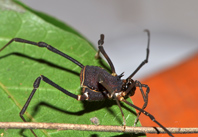Abstract
Lanthonia gen. nov. Coppard 2016 is a genus of clypeasteroid sand dollar whose members inhabit shallow, sandy waters from Mexico (including the Gulf of California) to Colombia in the tropical and subtropical eastern Pacific. Lanthonia includes Lanthonia longifissa (Michelin, 1858) and Lanthonia grantii (Mortensen, 1948), with L. longifissa hereby designated as the type species. Both L. longifissa and L. grantii were previously placed in the genus Mellita (L. Agassiz, 1841). However, levels of genetic divergence between a lineage containing L. longifissa and L. grantii and a lineage containing all other species of Mellita, including the type species M. quinquiesperforata (Leske, 1778), indicate genus level differentiation. The systematic interpretation of this group also supports the designation of this new genus as it allows the tree topology to be recovered from the nomenclature and clarifies the historical biogeography of these clades. This has resulted in members of both lineages today being sympatric in the eastern Pacific. Members of Lanthonia are morphologically differentiated from the type species of Mellita and all Pacific Mellita in having very narrow ambulacral regions between the food grooves and the ambulacral lunules on the oral surface, these being very broad in both M. quinquiesperforata and M. notabilis. The dentation of the bidentate pedicellariae also differentiate these genera, with small peripheral teeth present along the edge of the blade in species of Lanthonia and one to three enlarged intersecting teeth present distally in all species of Mellita.
References
Agassiz, L. (1841) Des Scutelles. Monographies des Echinoderms Vivans et Fossiles, Monograph 2, 1–151.
Budd, A.F. & Johnson, K.G. (1999) Origination preceding extinction during late Cenozoic turnover of Caribbean reefs. Paleobiology, 25, 188–200.
Caso, M.E. (1981) Contribución al estudio de los Echinozoa de México. La Familia Mellitidae Stefanini. Descriptión de una nueva especie del género Mellita. Mellita eduardobarrosoi sp. nov. Anales del Centro de Ciencias del Mar y Limnologia Universidad Nacional Autónoma de México, 7, 141–180.
Clark, H.L. (1940) Revision of the keyhole urchins (Mellita). Proceedings of the United States National Museum, 89, 435–444.
http://dx.doi.org/10.5479/si.00963801.89-3099.435Clark, H.L. (1947) A new and remarkable keyhole urchin, Mellita notabilis n. sp. Bulletin of the Southern California Academy of Sciences, 46, 77–78.
Cohen, K.M., Finney, S. & Gibbard, P.L. (2012) International Chronostratigraphic Chart. International Commission on Stratigraphy. Available from: http://www.stratigraphy.org (accessed 22 May 2012)
Collins, L.S. (1996) Environmental changes in Caribbean shallow waters relative to the closing tropical American seaway. In: Jackson, J.B.C., Coates, A.G. & Budd, A. (Eds.), Evolution and Environment in Tropical America. University of Chicago Press, Chicago, IL, pp. 130–167.
Coppard, S.E. (2008) A comparative analysis of the spatangoid echinoid genera Brissopsis and Metalia: a new genus and species of spatangoid (Echinodermata: Echinoidea: Brissopsidae) from the Philippines and the reassignment of Brissopsis persica to Metalia. Zootaxa, 1760, 1–23.
Coppard, S.E., Kroh, A. & Smith, A.B. (2012) The evolution of pedicellariae in echinoids: an arms race against pests and parasites. Acta Zoologica, 93, 125–148.
http://dx.doi.org/10.1111/j.1463-6395.2010.00487.xCoppard, S.E., Zigler, K. & Lessios, H.A. (2013) Phylogeography of the sand dollar genus Mellita: cryptic speciation along the coasts of the Americas. Molecular Phylogenetics and Evolution, 69, 1033–1042.
http://dx.doi.org/10.1016/j.ympev.2013.05.028Durham, J.W. (1961) The Echinoid Mellita in the Pacific Coast Cenozoic. Contributions in Science Los Angeles County Museum, 48, 3–12.
Gray, J.E. (1851) Proceedings of the Zoological Society. Vol. 19. Academic Press, London, 36 pp.
Harold, A.S. & Telford, M. (1990) Systematics, phylogeny and biogeography of the genus Mellita (Echinoidea: Clypeasteroida). Journal of Natural History, 24, 987–1026.
http://dx.doi.org/10.1080/00222939000770621Klein, J.T. (1734) Naturalis dispositio echinodermatum. Accesseit lucubratiuncula de aculeis echinorum marinorum, cum spicilegio de belemnitis. Gedani, Schreiber, 78 pp.
Knowlton, N. & Weigt, L.A. (1998) New dates and new rates for divergence across the Isthmus of Panama. Proceedings of the Royal Society Biological Sciences, 265, 2257–2263.
http://dx.doi.org/10.1098/rspb.1998.0568Leske, N.G. (1778) Iacobi Theodori Klein naturalis dispositio echinodermatum. Accesserunt lucubratiuncula de aculeis echinorum marinorum et spicilegium de belemnitis. Lipsiae, Gleditsch, 278 pp.
Marko, P.B. (2002) Fossil calibration of molecular clocks and the divergence times of geminate species pairs separated by the Isthmus of Panama. Molecular Biology and Evolution, 19, 2005–2021.
http://dx.doi.org/10.1093/oxfordjournals.molbev.a004024Melville, R.V. & Smith, J.D.D. (1987) Official Lists and Indexes of Names and Works in Zoology. The International Trust for Zoological Nomenclature, London, 366 pp.
Michelin, H. (1858) Revue des espèces du genre Mellita. Revue et Magasin de Zoologie Pure et Appliquée, 2 (PI. 8), 358–364.
Mooi, R. & Chen, C.P. (1995) Weight belts, diverticula, and the phylogeny of the sand dollars (Clypeasteroida: Echinoidea). Bulletin of Marine Science, 57, 186–195.
Mooi, R. & Harold, A.S. (1994) Anatomical observations of the sand dollar Mellita quinquiesperforata (Leske, 1778) (Echinodermata: Echinoidea) and the designation of a neotype. Proceedings of The Biological Society of Washington, 107, 751–759.
Mortensen, T. (1948) A Monograph of the Echinoidea. IV, 2. Clypeastroida. Clypeastridæ, Arachnoidæ, Fibulariidæ, Laganidæ and Scutellidæ. C. A. Reitzel, Copenhagen, 471 pp.
Pomel, A. (1883) Classification méthodique et genera des échinides vivantes et fossiles. Thèses présentées à la faculté des Sciences de Paris pour obtenir le grade de docteur ès sciences naturelles 503, Adolphe Jourdan, Alger, 131 pp.
Smith, A.B. & Ghiold, J. (1982) Roles for holes in sand dollars (Echinoidea): a review of lunule function and evolution. Paleobiology, 8 (3), 242–253.
Smith, J.T. & Jackson, J.B.C. (2009) Ecology of extreme faunal turnover of tropical American scallops. Paleobiology, 35, 77–93.
http://dx.doi.org/10.1666/07054.1Stefanini, G. (1912) Osservazioni sulla distribuzione geografica, sulla origini e sulla filogenesi degli Scutellidae. Bolletino della Societe Geologica Italiana, 30 (1911), 739–754.
Telford, M. (1983) An experimental analysis of lunule function in the sand dollar Mellita quinquesperforata (Leske). Marine Biology, 76, 125–134.
http://dx.doi.org/10.1007/BF00392729Ward, R.D., Holmes, B.H. & O’Hara, T.D. (2008) DNA barcoding discriminates echinoderm species. Molecular Ecology Resources, 8, 1202–1211.
http://dx.doi.org/10.1111/j.1755-0998.2008.02332.x

